A Hundred Years on, the Ner-A-Car Is Still a Weird, Wonderful Machine
Motorcycle stunt riding is far from a recent phenomenon, judging from a report of tests of a Ner-A-Car carried out in the mid 1920s. A lady named Mabel Lockwood-Tatham was evaluating a two-stroke Ner-A-Car, recounted journalist Vic Willoughby in his book Classic Motorcycles.
“Riding ‘no hands’ with great confidence, she was surprised to see her escort, on similar models, either standing on the engine casing with hands in pockets, or lying flat on their backs on the saddle. Such gimmicks proved the stability of the Ner-A-Car.”
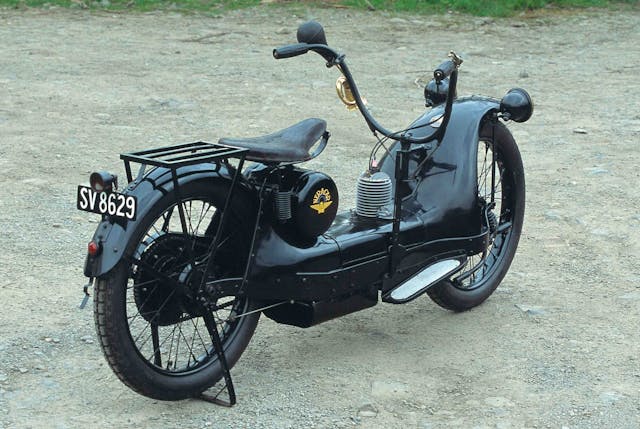
That was all very well for Ms. Lockwood-Tatham and her colleagues, who were no doubt experienced Ner-A-Car riders. But many years later I’m feeling distinctly less confident as I prepare to ride the elderly machine for the first time. With its reputation for stability and a top speed of only about 40mph, the Ner-A-Car should be one of the safest bikes ever built. But right now, it’s distinctly intimidating.
I’m sitting on the long, low American-made machine’s saddle with the little two-stroke engine poking up below my knees, as classic specialist Stuart Mayhew, the bike’s owner, explains how everything works. Hardly any of the controls are where years of riding bikes dictate they should be. Well, admittedly the horn control is roughly in the familiar place on the left handlebar—but it’s not a button, it’s a squashy rubber ball that sounds a curly brass klaxon.
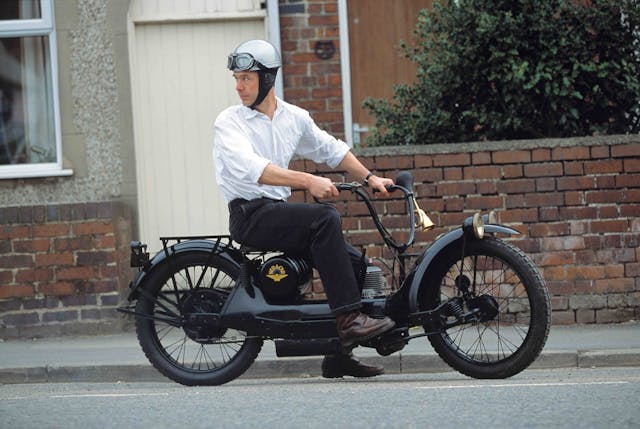
True, the clutch is also operated by a device on the left handlebar—but instead of a lever, it’s a throttle-style twist-grip. Over on the right handlebar, the throttle is worked by a small lever, which sits alongside another lever that controls the fuel mixture. The front brake lever looks almost conventional, except that it works one side of the twin-sided rear drum. The other side is operated by the rider’s left boot; there’s no front brake at all.
Confused? I certainly was, even before I reached forward with my right hand to select a gear with the long vertical lever sticking out of the engine’s sheet-metal cover. Then I cautiously twisted the clutch and nudged the throttle with my thumb to turn out into what suddenly seemed like a very busy street. I became quite conscious that the hub-centre steered front wheel, hidden from my view by a huge mudguard, seemed to be turning further to the right than the handlebars. And indeed it was, due to the geared steering system.
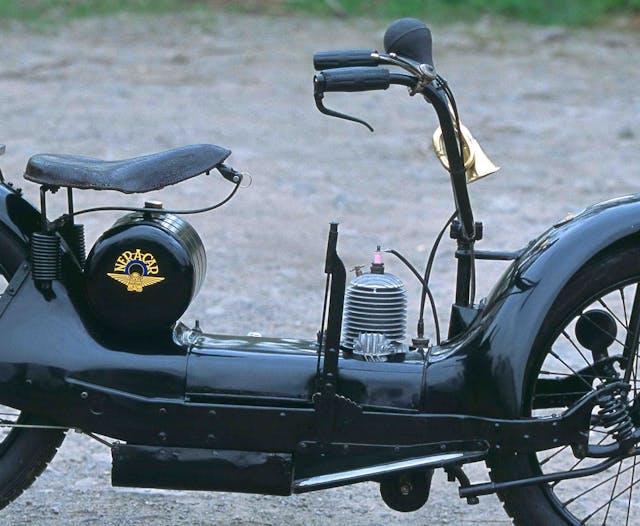
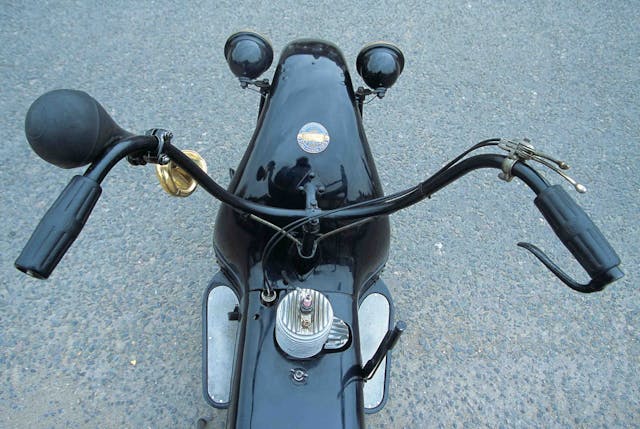

Curiouser and curiouser. For a bike that is an early ancestor of modern scooters, the Ner-A-Car is a strange device. Given that this machine was built in 1925, it’s hardly surprising that it’s very different to any modern motorbike. But the Ner-A-Car was weird by the standards of its own day, too.
Even the name is eccentric, though doubly appropriate. The Ner-A-Car was invented by American Carl Neracher. More to the point, when he built his first machine in 1921, Neracher’s creation was as “Near A Car” in its concept and its level of weather protection as any two-wheeled vehicle had been.
The Ner-A-Car Corporation’s advertisement in Popular Mechanics that year was headed “Motoring on Two Wheels” and described “a car of smart style, a car of fascinating action. Everybody who tries it says there’s nothing like it on wheels – it’s more like an aeroplane.”
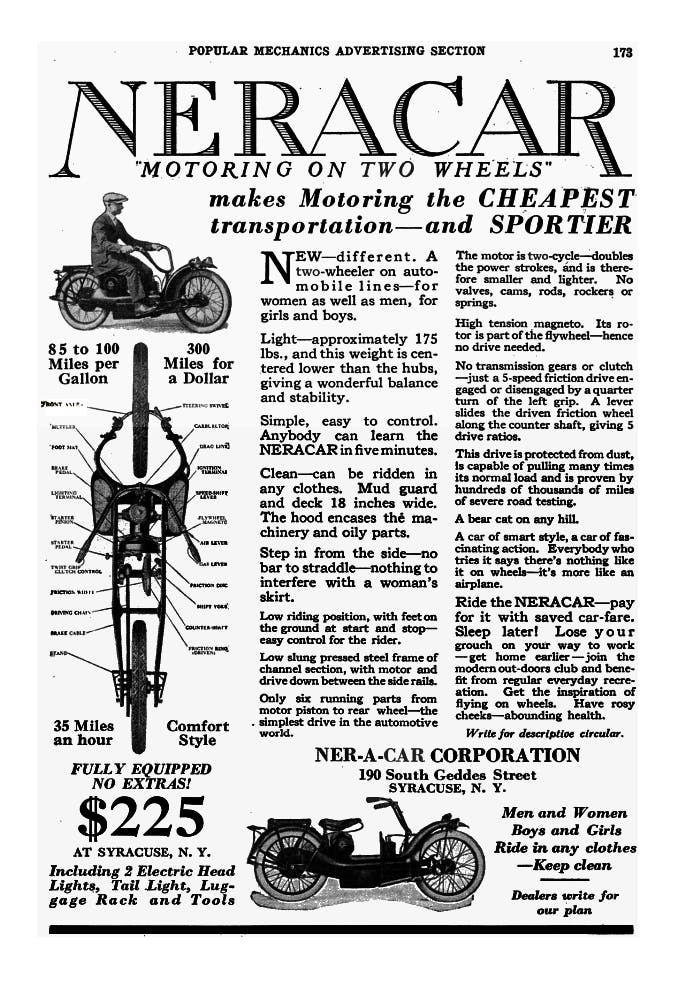
Well, maybe. A more reliable claim is that the Ner-A-Car featured motorcycling’s first production example of hub-centre steering. The twin-sided front suspension arms were connected to a low, flat chassis formed mainly from pressed steel. The rider sat upright on a sprung saddle, with feet well forward and arms out, grasping those long handlebars. A cylindrical fuel tank was below the saddle.
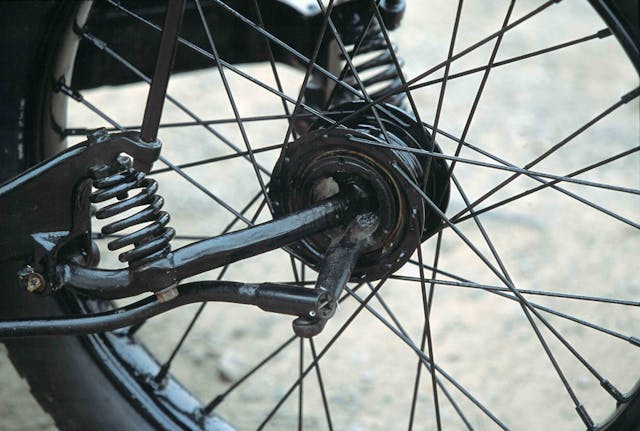
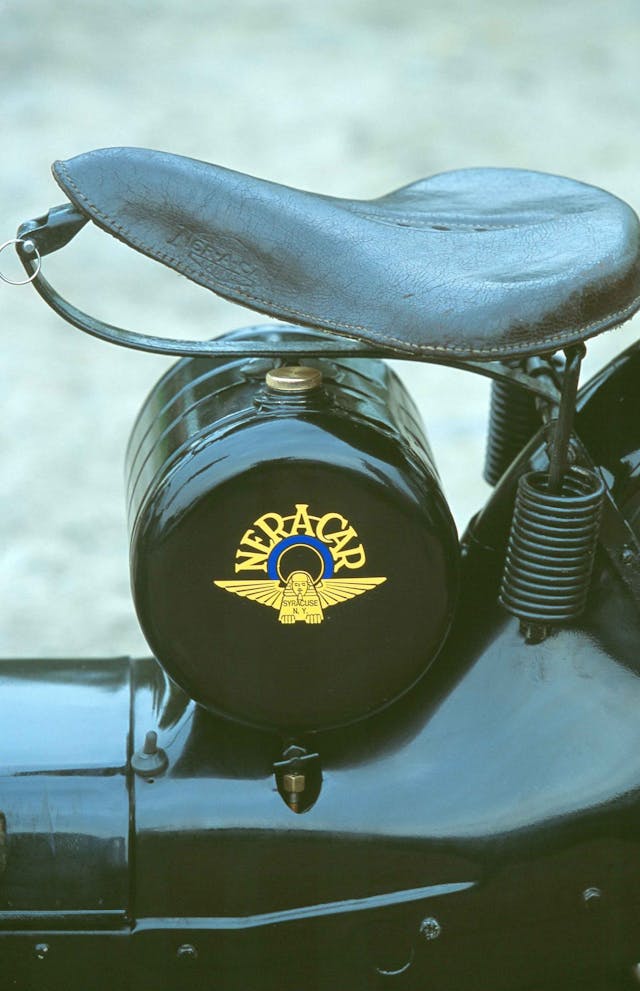
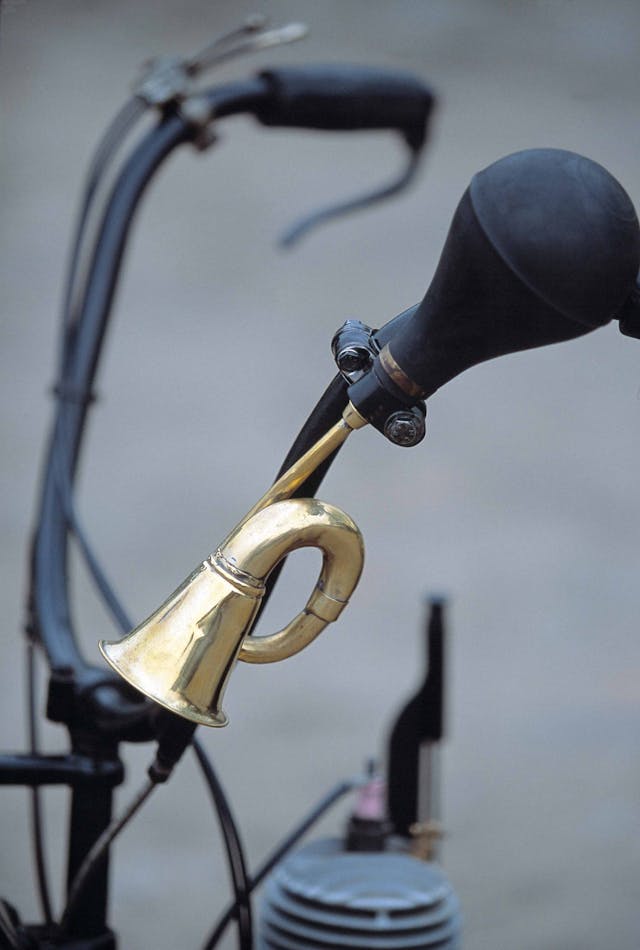
This chassis arrangement allowed the engine to be situated very low in the frame, which did much to give the Ner-A-Car the stability for which it became known. When production began in Syracuse, New York, the engine was a 211cc air-cooled two-stroke. Capacity had been increased to 255cc by the time the firm built this bike, which spent most of its life in France before being restored.
Neracher’s original, and distinctive, transmission system required some attention to operate. The engine turned a large flywheel, positioned across the frame. This drove an alloy wheel of similar diameter, which was located at 90 degrees to it (i.e. along the line of the bike), and which pressed against the spinning flywheel, gripping thanks to a fibre ring around its edge. This large alloy wheel turned a shaft, at the other end of which was the final drive sprocket.
When the rider moved the long gear lever, the alloy wheel was moved sideways across the spinning face of the flywheel toward its centre, changing the ratio of engine speed to drive. In theory this provided a stepless variation from lowest to highest gear, but Neracher put five notches in the gear lever mount, to give five distinct ratios. As for the clutch, twisting the left-hand grip worked a cable that pulled the alloy wheel backwards, away from the spinning flywheel.

Neracher’s system was simple in theory, but tricky to operate—partly because there was no clutch spring, so it was up to the rider to keep that wheel pressed against the flywheel and thus power going through to the back wheel. Not that this exactly required a huge amount of strength, as the little two-stroke motor produced only a few horsepower.
At least starting the bike was easy, as the engine putt-putted into life after only the lightest of kicks on the lever on the left of the pressed-steel flank. I had plenty to think about as I made sure the gear lever was in first, dialled in a little throttle with the lever, then gradually twisted the left grip to ease out the clutch.
Once I’d negotiated my first slow-speed turn to join the road, with the Ner-A-Car feeling very strange indeed, it accelerated smoothly, if with no great enthusiasm, up to about 30 mph as I held the clutch home and dialed in a bit more throttle. Changing gear proved slightly less difficult than I’d imagined, partly because the throttle had no return spring. The engine carried on revving as I fiddled with the gear lever using my right hand, while twisting in the clutch with my left.

Maximum revs for the little two-stroke motor were about 2500rpm. There was a fair bit of vibration at higher speeds, perhaps due to a cracked engine mount that was found and repaired after my ride. The big front mudguard provided a bit of weather protection, which was useful as spits of rain began to fall.
The sensation of speed was increased because the rear brake wasn’t exactly powerful, whether I squeezed the handlebar lever, stomped on the pedal, or both. Suspension was limited to small springs up front and the sprung saddle at the rear, so the ride would have been harsh on bumpy roads.
Handling wasn’t bad at all, though, at least if I ignored the strange low-speed behaviour caused by that linked steering column. At barely more than 175 lbs, the Ner-A-Car was light, and its low centre of gravity and hub-centre steering arrangement gave a relaxed feel that was welcome in its day.

“Ignore the handlebar and you can ride for miles by applying toe pressure to the footboards,” wrote renowned tester Titch Allen several decades later. “The machine will bank and swoop with the grace and precision of an ice skater. In its day, when there was less uniformity of controls and plenty of space for manoeuvre on the road, the peculiarities of the early models were not so much of a problem.”
In 1922, legendary long-distance ace Erwin “Cannonball” Baker proved the Ner-A-Car’s durability by covering the 3364 miles from New York to Los Angeles in 174 hours’ riding, averaging almost 20mph. He later opened a dealership in LA selling the Neracar (those sold stateside lacked the hyphens in their name).
But the bike’s modest performance generally limited its appeal to riders whose journeys were short. “It was the ideal machine for the parish priest with a scattered rural flock and the district nurse in a not-too built-up area,” concluded Allen.
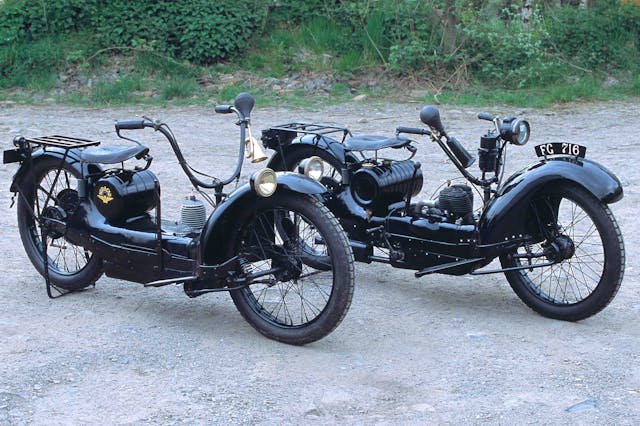
Alongside the US production, Neracher licensed British firm Sheffield-Simplex, producers of high quality cars, to manufacture a version for sale in Britain and other countries. The firm from Kingston-on-Thames in Surrey enlarged the two-stroke engine to 285cc, and later also built Model B and C versions with more powerful 350cc Blackburne four-stroke engines and three-speed gearboxes.
In 1926, Sheffield-Simplex introduced an upmarket De-Luxe model with rear suspension, an air-cushion bucket seat, adjustable windscreen, and an instrument panel. But although the firm advertised earls, duchesses, and other aristocrats as being among its customers, it went out of business not long after.
Production on both sides of the Atlantic ended before the end of the decade. By then more than 6000 Ner-A-Cars had been sold in Britain, as well as approximately 10,000 in America. They do pop up at auction from time to time and have tended to command prices between $18,500 and $25,500. If your riding plans include no-handed stunts, no other classic comes close.
***
Check out the Hagerty Media homepage so you don’t miss a single story, or better yet, bookmark it. To get our best stories delivered right to your inbox, subscribe to our newsletters.



Clearly the spiritual predecessor to Dan Gurney’s AAR Alligator.